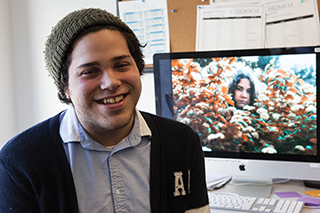Featured Artist: Ricardo Bouyett
February 24, 2014

When junior photographymajor and fine art photographer Ricardo Bouyett hikes up a mountain, explores a forest preserve or dances in a field, he brings his Canon 60D camera along.
After delving into photography two years ago, Bouyett received the 2013 Applied Arts student award, was featured in Applied Arts magazine and had two images chosen to be displayed Jan. 24 through March 1 at The Center for Fine Art Photography’s Wondrous Indeed exhibition in Fort Collins, Colo., where his image “Freedom in Youth” received an honorable mention.
Bouyett shoots digitally and uses Photoshop to create “dreamscapes”—photographs in which he manipulates the focus and colors while he edits the photos he recently took.
Bouyett said his photography is inspired by cinema, music and poetry which he uses to evoke traumatic experiences shared by either him or his friends.
Bouyett said he wants his photographs to be “visual therapy” for viewers and he hopes the emotional message of his work resonates with his audience.
The Chronicle sat down with Bouyett to discuss his award-winning work and artistic process.
THE CHRONICLE: What is the Wondrous Indeed exhibition?
RICARDO BOUYETT: In Fort Collins there is this place called the Center of Fine Art Photography, and they’re doing this thing called the Wondrous Indeed exhibition juried by Phillip Toledano. He is a fine art photographer and he had a call for submissions back in October. I applied just for fun and I got accepted. The exhibit is pretty much about the fantastical and the wonders that exist in everyday life but we just don’t see, so he accepted images that were realistic but also fantastical, which is where I came in…. One [of the chosen images] was called “Freedom in Youth.” The other is called “Oddities of the Mind.”
CC: Why do you think “Freedom in Youth” won honorable mention?
RB: It was raining and it was the day before my birthday and I was in a really moody mindset so I went to this field back in the suburbs. I turned on music and just started dancing and taking photos … and these kids just crowded around me and started watching me. So, when I started editing, I saw all these poses I was doing when I was dancing. I felt alive in some sense, but also free. All you see [in the picture] is 5–6 dancers grouped together in the center and they have no heads…. All you see are red leaf particles flying around…. I used [the leaves] as a symbol of the beauty that exists beyond our skin. We are bound by so much inhibition, both societal and personal, and it’s a struggle.
CC: What is the concept of “Oddities of the Mind?”
RB: I just made it recently … and it’s a psychological piece. It’s about overthinking, [and] also about the concept of identity and the relationship between your conscious thought and your unconscious thought and this whirlwind of just not existing. The picture is a self portrait, me sitting in a suit with a table in the basement of my apartment complex and all you see is this whirlwind coming up from [my head]. It’s interesting because you’re wondering, “What’s going on with this person?” It’s an investigation on what goes on in people’s heads through photography.
CC: How did you feel when you found out that your images were chosen?
RB: Surreal. It didn’t hit me at first … I was in tears, mostly because of how happy I was, because I’ve worked really hard day after day to make images, not for recognition, just for the sake of creating conversation about things that matter, such as the human psyche or personal relationships. So to have a place recognize that meant a lot to me.







